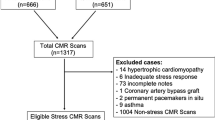Abstract
Background
Regadenoson (REG), a selective adenosine A2a receptor agonist, is becoming the preferred pharmacologic agent for stress myocardial perfusion imaging (MPI). Hemodynamic and stress variables, immediate safety and use of aminophylline when using REG combined with low-level exercise (REG WALK MPI) compared with REG MPI, have not been well studied and formed the basis of our study.
Methods
Retrospective evaluation of patients who underwent REG MPI (n = 887) was compared to patients undergoing REG WALK MPI (n = 485) from January to November 2009. Patient demographics, hemodynamic parameters, REG MPI data, side effects, immediate major clinical events, and use of aminophylline were evaluated.
Results
Patients in REG WALK MPI group tended to be younger, male and obese compared to patients in REG MPI group. REG WALK MPI patients had higher stress heart rate (103 ± 20.5 vs 84 ± 19 bpm, P = .001), higher heart rate reserve (36.3 ± 19 vs 14.7 ± 15.5 bpm, P < .001), and greater systolic blood pressure rise (4.8 ± 21.3 vs −8.9 ± 19.8 mm Hg, P < .001), compared to REG MPI patients. No major adverse events were reported immediately after REG WALK MPI. There were no differences in drug-related side effects in between the two groups; however, the use of aminophylline was lower in REG WALK MPI Group (5.6% vs 11.4%, P = .001).
Conclusion
REG WALK MPI gives more favorable hemodynamic response with lesser use of aminophylline and no increase in adverse events when compared with REG MPI.

Similar content being viewed by others
References
Jaroudi WA, Iskandrian AE. Regadenoson: a new myocardial stress agent. J Am Coll Cardiol 2009;54:1123-30.
Garnock-Jones KP, Curran MP. Regadenoson. Am J Cardiovasc Drugs 2010;10:65-71.
Palani G, Husain Z, Cabrera R, Karthikeyan V, Karthikeyan AS, Ananthasubramaniam K. Safety of regadenoson as a pharmacologic stress agent for myocardial perfusion imaging in chronic kidney disease patients not on hemodialysis. J Nucl Cardiol 2011;18:605-11.
Botvinick EH. Current methods of pharmacologic stress testing and the potential advantages of new agents. J Nucl Med Technol 2009;37:14-25.
Spicuzza L, Di Maria G, Polosa R. Adenosine in the airways: implications and applications. Eur J Pharmacol 2006;533:77-88.
Auchampach JA, Bolli R. Adenosine receptor subtypes in the heart: therapeutic opportunities and challenges. Am J Physiol 1999;276:H1113-6.
Gemignani AS, Abbott BG. The emerging role of the selective A2A agonist in pharmacologic stress testing. J Nucl Cardiol 2010;17:494-7.
Dhalla AK, Wong MY, Wang WQ, Biaggioni I, Belardinelli L. Tachycardia caused by A2A adenosine receptor agonists is mediated by direct sympathoexcitation in awake rats. J Pharmacol Exp Ther 2006;316:695-702.
Thomas GS, Thompson RC, Miyamoto MI, Ip TK, Rice DL, Milikien D, et al. The RegEx trial: a randomized, double blind, placebo and active-controlled pilot study combining regadenoson, a selective A2A adenosine agonist, with low-level exercise, in patients undergoing myocardial perfusion imaging. J Nucl Cardiol 2009;16:63-72.
Pennel DJ, Mavrogeni SI, Forbat SM, Karwatowski SP, Underwood SR. Adenosine combined with dynamic exercise for myocardial perfusion imaging. J Am Coll Cardiol 1995;25:1300-9.
Thomas GS, Miyamoto MI. Should simultaneous exercise become the standard for adenosine myocardial perfusion imaging? Am J Cardiol 2004;94:3D-10D. (discussion 10D-11D).
Kwon DH, Cerqueira MD, Young R, Houghtalling P, Lieber E, Menon V, et al. Lessons from the regadenoson and low-level treadmill/regadenoson myocardial perfusion imaging: initial clinical experience in 1263 patients. J Nucl Cardiol 2010;17:853-7.
Hansen CL, Goldstein RA, Akinboboye OO, Berman DS, Botvinik EH, Churchwell KB, et al. Myocardial perfusion and function: single photon emission computed tomography. J Nucl Cardiol 2007;14:e39-60.
Gauda EB, Northington FJ, Linden J, Rosin DL. Differential expression of A2A, A1-adenosine and D2-dopamine receptor genes in rat peripheral arterial chemoreceptors during postnatal development. Brain Res 2000;872:1-10.
Dhalla AK, Wong MY, Wang WQ, Biaggioni I, Belardinelli L. Tachycardia caused by A2A adenosine receptor agonists is mediated by direct sympathoexcitation in awake rats. J Pharmacol Exp Therapy 2006;316:695-702.
Cerqueira MD, Nguyen P, Staehr P, Underwood SR, Iskandrian AE. Effects of age, gender, obesity, and diabetes on the efficacy and safety of the selective A2A agonist regadenoson versus adenosine in myocardial perfusion imaging integrated ADVANCE-MPI trial results. JACC Cardiovasc Imaging 2008;1:307-16.
Mahmarian JJ, Cerqueira MD, Iskandrian AE, Bateman TM, Thomas GS, Hendel RC, et al. Regadenoson induces comparable left ventricular perfusion defects as adenosine: a quantitative analysis from the ADVANCE MPI 2 trial. JACC Cardiovasc Imaging 2009;2:959-68.
Doukky R, et al. Attenuation of the side effect profile of regadenoson: a randomized double-blind placebo-controlled study with aminophylline in patients undergoing myocardial perfusion imaging: ‘the ASSUAGE trial’. J Nucl Cardiol 2012;19:448-57.
Husain Z, Palani G, Cabrera R, Karthikeyan AS, et al. Hemodynamic response, arrhythmic risk, and overall safety of regadenoson as a pharmacologic stress agent for myocardial perfusion imaging in chronic obstructive pulmonary disease and asthma patients. Int J Cardiovasc Imaging 2012;28:1841-9.
Acknowledgments
The authors thank Nandita Mani, BLIS, Sladen Library Henry Ford Hospital, for her expert assistance in manuscript preparation.
Disclosures
Research grant support/Speakers Bureau: Astellas Pharma US Inc (KA), Lantheus Medical Imaging.
Author information
Authors and Affiliations
Corresponding author
Additional information
See related article, doi:10.1007/s12350-013-9695-1.10.1007/s12350-013-9695-1
Rights and permissions
About this article
Cite this article
Cabrera, R., Husain, Z., Palani, G. et al. Comparison of hemodynamic and stress testing variables in patients undergoing regadenoson stress myocardial perfusion imaging to regadenoson with adjunctive low-level exercise myocardial perfusion imaging. J. Nucl. Cardiol. 20, 336–343 (2013). https://doi.org/10.1007/s12350-012-9671-1
Received:
Accepted:
Published:
Issue Date:
DOI: https://doi.org/10.1007/s12350-012-9671-1




